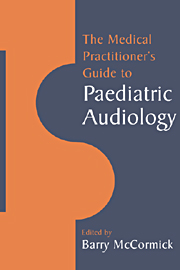Book contents
- Frontmatter
- Contents
- List of contributors
- Preface
- Acknowledgement
- 1 Introduction to hearing problems in childhood
- 2 Causes of deafness
- 3 Behavioural tests
- 4 Pure tone audiometry
- 5 Objective hearing tests
- 6 Middle-ear measurements
- 7 The management of otitis media with effusion
- 8 Management of unilateral hearing loss
- 9 Management of sensorineural hearing loss
- 10 Cochlear implants
- Index
8 - Management of unilateral hearing loss
Published online by Cambridge University Press: 01 October 2009
- Frontmatter
- Contents
- List of contributors
- Preface
- Acknowledgement
- 1 Introduction to hearing problems in childhood
- 2 Causes of deafness
- 3 Behavioural tests
- 4 Pure tone audiometry
- 5 Objective hearing tests
- 6 Middle-ear measurements
- 7 The management of otitis media with effusion
- 8 Management of unilateral hearing loss
- 9 Management of sensorineural hearing loss
- 10 Cochlear implants
- Index
Summary
Introduction
Unilateral hearing loss occurs when there is some degree of hearing loss in one ear with normal hearing in the other. Many children suffer from conductive hearing loss in childhood and some of these may be unilateral losses for some of the time. This chapter, however, is concerned with the case of permanent unilateral loss, which is almost always sensorineural in nature.
Prevalence
Accurate figures for the presence of unilateral sensorineural loss are hard to come by. Some studies (Everberg, 1960; Tarkkanen and Aho, 1966) have estimated prevalence at around 1:1000 in school children.
Aetiology
Aetiological information is also problematic and the well known difficulties in establishing aetiology for sensorineural hearing loss are compounded in the case of unilateral loss by the often relatively late age at which it is ascertained. Many studies have suggested that unknown aetiology is the largest group (approximately 50%) with mumps, measles and meningitis accounting for the majority of identifiable causes.
Psychoacoustic advantages of binaural hearing
There are several advantages to binaural hearing and it follows that the unilaterally impaired child is deprived of these. The main psychoacoustic phenomena related to binaural hearing are as follows.
Binaural summation: The binaural threshold is around 3 dB better than the monaural threshold. This also applies to supra-threshold stimuli so that binaural sounds are louder than monaural sounds by between 3 and 6 dB.
- Type
- Chapter
- Information
- The Medical Practitioner's Guide to Paediatric Audiology , pp. 87 - 95Publisher: Cambridge University PressPrint publication year: 1995

